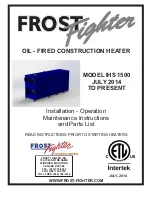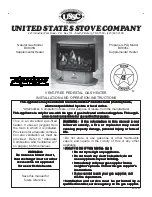
Installation & Operation Manual
15
3
System piping
(continued)
Water Heater Pump Applications
Model
*Pipe
Size
Armstrong Grundfos
Flow Rate
(GPM)
Loss
(FT/HD)
Temp.
Rise
151
1-1/4"
E8
--
16
16.6
18°F
200
1-1/4"
E8
--
21
11.8
18°F
286
2"
E17
--
30
17.1
18°F
400
2"
E24
--
39
21
18°F
501
2"
E22
--
53
26
18°F
601
2"
E22
--
53
26
22°F
701
2"
--
TP 40-160
63
32
22°F
801
2"
--
TP 40-160
67
31
24°F
Table 3C Water Heater Pump Applications / Recommended
Temperature Rise
Piping components
Water heater system piping:
Water heater system piping MUST be sized per the pipe
requirements listed in FIG.’s 3-9 and 3-10. Reducing the pipe
size can restrict the flow rate through the water heater, causing
inadvertent high limit shutdowns and poor system performance.
Check valves:
Field supplied. Check valves are recommended for installation
as shown in FIG.’s 3-6 thru 3-10.
Water heater isolation valves:
Field supplied. Full port ball valves are required. Failure to use
full port ball valves could result in a restricted flow rate through
the water heater.
Anti-scald mixing valve:
Field supplied. An anti-scald mixing valve is recommended
when storing domestic hot water above 115°F.
Unions:
Field supplied. Recommended for unit serviceability.
Temperature and pressure relief valve:
Factory supplied on water heaters. The temperature and pressure
relief valve is sized to ASME specifications. Storage tanks may
require additional valves depending on local codes.
Tank sensor:
Lochinvar supplies a tank sensor. The tank sensor must be
installed in the tapping provided in the lower 25% of the storage
tank to achieve proper operation. As shipped from the factory,
the tank sensor is in the literature package shipped with the unit.
Placing the sensor in the tapping provided on the storage tank
will improve temperature response and prevent short cycles of
operation.
Pump sizing and flow requirements are based on 45 feet of
piping, 4 - 90° elbows, and 2 - fully ported ball valves.
NOTICE
Water chemistry
NOTICE
The required temperature rise and the
standard circulating pump are sized based
on the heating of potable water with a
hardness of 5 to 25 grains per gallon and
a total dissolved solids not exceeding 350
ppm. Consult the manufacturer when
heating potable water exceeding these
specifications.
Heating of high hardness and/or high total dissolved solids
water may require a larger circulating pump, and a revised
temperature rise specification based on the water chemistry of
the water to be heated.
Water with a hardness of less than 5 grains per gallon will
usually have a pH which can be aggressive and corrosive
causing non-warrantable damage to the pump, and associated
piping. Corrosion due to water chemistry generally shows up
first in the hot water system because heated water increases
the rate of corrosive chemical reactions.
The following chart (Table 3B) details the relationship of water
temperature and time with regard to scald injury and may be
used as a guide in determining the safest water temperature for
your applications.
APPROXIMATE TIME / TEMPERATURE
RELATIONSHIPS IN SCALDS
120°F
More than 5 minutes
125°F
1 1/2 to 2 minutes
130°F
About 30 seconds
135°F
About 10 seconds
140°F
Less than 5 seconds
145°F
Less than 3 seconds
150°F
About 1 1/2 seconds
155°F
About 1 second
Table 3B Approximate Time / Temperature Scald Chart
















































